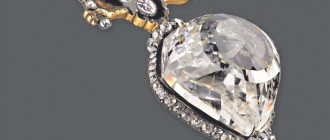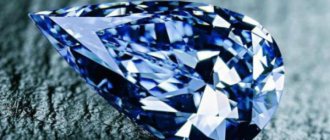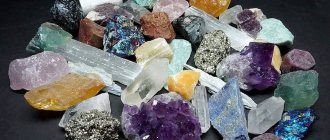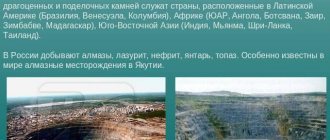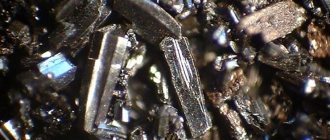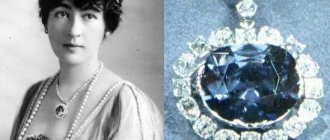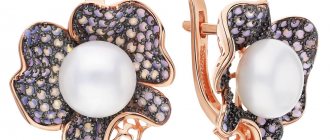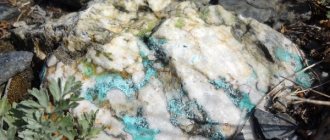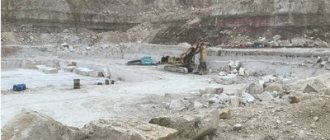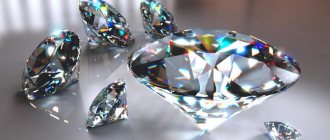Humanity has always loved riddles and puzzles, with which Mother Nature has surrounded it in large quantities.
It’s one thing when a human hand is attached to the phenomenal characteristics of an object or phenomenon—people then find explanations. In any case, they think they know the nature of the phenomenon. It’s a completely different matter if a mysterious phenomenon is inexplicable from the point of view of science and all existing laws of physics. For example, the hanging stone in Jerusalem is a block of stone that “hovered” in the air. Many attribute the Divine principle to the phenomenon, and some consider it pure fiction.
Divine sign
The miraculous stone is attributed to Islamic tradition, when the Prophet Muhammad was on his way from Mecca (Al-Haram Mosque) to the Holy Land in Jerusalem (Al-Aqsa Mosque). It is believed that the miraj, that is, the ascension of the prophet to heaven, occurred in 619. The transfer of the prophet was carried out instantly on the burak, and angels accompanied him.
Burak is a mythological creature from the Muslim religion, endowed with intelligence. Burak has the body of a horse and a human head. The legend says that a flying horse carried Muhammad to Jerusalem so quickly that the water from the overturned jug did not have time to flow out onto the ground.
Burak's strength and speed were so great that even a huge stone rushed into the air after him. But Muhammad stopped him and he remained suspended in the air. It is believed that the Jews tried to hide the phenomenon from ordinary people and tried to build a support under the stone, pouring earth under it. However, the block invariably rose into the air.
Types of sun stone
For sunstone, several varieties are distinguished according to their main deposits:
- Oregon stones (heliolites, golden labradorite) are transparent gems with a bright straw-yellow color. Occasionally pink, red-orange, peach and greenish-blue specimens are found. Due to multiple microscopic impurities of copper, crystals of this type are distinguished by a bright golden-red sheen.
- Mexican stones (royal golden labradorite) are minerals containing iron and are distinguished by a pronounced dark straw color. They have a low refractive index and high gloss, as well as a pseudo-dispersion effect.
- Norwegian stones (microclines, oligoclases) are colored in orange-brown tones, contain admixtures of goethites and hematites, and are distinguished by a radiant shine.
- Tanzanian stones (oligoclase, Maasai stones, confetti) - are characterized by a gray-green hue with sparkling tints, due to the admixture of scaly hematite. Some red-yellow specimens have an aventurescence or “cat’s eye” effect.
- Congo stones (andesines) - distinguished by samples of either light green or red.
- Indian stones - with a red-orange color and inclusions of biotite, shiny, iridescent.
Fact or Fiction
That's the whole legend thanks to which rumors circulate around the Jerusalem Hanging Stone. By the way, no one has yet proven that a block of several hundred tons hovering above the ground is located in Jerusalem. There are only a couple of photographs on the Internet, one of which is especially vigorously discussed on forums and given conflicting explanations.
Why contradictory? How else can we interpret the fact that no one can specifically indicate the place where the hanging object is located? And can a stone even hang in the air? Perhaps this is just a successful photo montage or refraction of light when the photographer took a sensational photo?!
There is more than one version of the location of the phenomenal stone: some claim that it is in Palestine, others that it is in Saudi Arabia, in the settlement of Al Hassa . There are rumors that the monolith hangs above the ground at a distance of about 10 cm, and then returns to its original place.
Some Muslims perceive stories about the miracle stone and its photograph as a sign from Allah! Let everyone remain with their faith! If we think logically, then there would clearly be a fuss around such an anomalous phenomenon (no matter where in the world it occurs):
- numerous publications;
- eyewitness accounts,
- information in the media and television and radio broadcasting;
- and other.
Take, for example, the famous hanging stone in Khakassia (Russia), near the Bely Iyus River. A piece of a block weighing 600 tons stands on a sloping plane on a thin edge. It seems that one push of the hand will be enough for the block to fall into the abyss. However, this does not happen.
Many researchers came to the site to study the anomaly: the object was measured and captured in photographs from different angles. Once upon a time it swayed, but “thanks” to those who wanted to throw it off the cliff, the monolith became even more firmly established in its “nest.” Now it doesn't wobble, but it doesn't fall either.
History of the Black Stone of the Kaaba
The black stone of the Kaaba in Mecca is a composite object several hundred or even thousands of years old.
The Kaaba is a cubic building covered with black silk with a pattern embroidered in gold. It reaches 15.2 m in height, 10.7 m in width, and 12.2 m in length. There is a golden door on the south-eastern side of the building. The room inside the Kaaba has three pillars and a marble and limestone floor.
The sacred mineral is located in the eastern part, on display for visitors to the temple; anyone can touch it. The gem, set in gold and silver, is located at a height of just over 1.5 m, as if hanging in the air.
According to Muslim customs, every believer must visit a sacred place and kiss the stone. And if it is not possible to kiss, then you need to at least point your hand at the shrine and read a prayer.
The tradition of venerating the relic dates back to ancient times, originating in pre-Islamic times. It is believed that many centuries ago the mineral belonged to the Quraish tribe. They believed that the gem was sent from heaven and revered it as a valuable relic.
During the formation of Islam, the Prophet Muhammad condemned any idolatry and led an active struggle against relics of the past such as totems and amulets. But he considered the black gem to be an exception. Muhammad himself once belonged to the Quraysh and believed that the dark stone was a symbol of knowledge of the world.
Islam denies the spiritualization of objects, therefore, for Muslims, a black stone is only an object characterized by a divine nature. It symbolizes the connection with the other world, and is also revered as a historically significant object, because it was touched by the hand of the Prophet Muhammad.
During the Hajj, many Muslims come to the Kaaba to kiss the relic, just like Muslim met in the Quran. The words belong to him: “Oh, yes, I swear by Allah, but I know very well that you are just a stone! It’s just that if I had not seen the Messenger of Allah (peace and blessings of Allah be upon him) kissing you, then I would not have kissed you.”
The words of Muslim mention a certain messenger of Allah, known as Prophet Ibrahim. According to the Koran, he took upon himself the responsibility of building the Kaaba.
Anomalous phenomena
The world knows similar phenomena that science cannot explain: monoliths hanging in the air, flying or screaming blocks of stone. There is evidence that famous buildings, such as the pyramids in Egypt or temples in India, were built using flying stones. They rose into the air not on their own, of course, but due to a certain sound made by the people involved in the construction.
Some will probably exclaim that this is fiction. What about the Lebanese South Stone, which weighs almost 1000 tons? It is impossible to move it from its place with modern technology, and the builders of the temple in the ancient city of Baalbek (Lebanon) were going to use it in the construction of the shrine. They say that he was left lying just a few minutes' walk from the temple. It is unlikely that he could be pulled to the structure using ropes and the strength of slaves, as was always believed.
To believe or not to believe, let everyone decide for themselves! The last modern story in favor of the existence of monoliths floating above the ground takes place in the Indian settlement of Shivapur. There, during daytime prayer, the monks, surrounding an impressively sized stone (62.5 kg), begin to chant a prayer or mantra. Having reached a certain peak of sound in the chant, the monks raise it with just one finger. When the singing stops, the monks quickly jump away as the “hanging” block falls down into its place . But the most important point is the number of singers - there are always 11 people.
Physico-chemical characteristics of solar stone
— Advertising —
Chemically, sunstone is a silicate, a complex mineral that contains albite and anorthite.
The stone is painted orange-red with sparkle. Its crystals have a triclinic system, glassy luster, perfect cleavage, they are transparent or translucent, with a conchoidal fracture and high fragility.
The hardness of sunstone on the Mohs scale is 6. Density is 2.66 g/cm3. It practically does not melt and is poorly soluble in acids.
The special radiance of the sunstone is due to the fact that its crystals contain a suspension of hematite or copper flakes. Some subspecies exhibit the effect of asterism (star sun stones).
How to distinguish a real sunstone from a fake
Sunstone counterfeits are associated with the success of glass manufacturers in Venice, who invented the so-called “aventurine glass.” During cooling, the craftsmen mixed copper into the melted glass, the crystals of which did not oxidize or change color, but shone in the glass like gold. However, the refractive index of light between glass and natural stone is significantly different, and therefore it is quite easy to distinguish a fake of this kind.
Now spars, which are used to make imitations, are heated with crushed copper. The outer layer of such stones develops an orange-red color and sparkle, after which they are cut and polished.
In order to distinguish a natural sunstone from a fake, it is recommended:
- Hold it in a tightly clenched hand. Only imitations heat up quickly from the heat of the human body.
- Estimate the weight of the stone: natural is always quite heavy.
- Tap it on a hard surface. A special “empty” sound also indicates imitation.
Where can I get a floating platform?
The floating platform is sold inside the Teapot of Serenity at the well-known Puffy.
This object is located in Puffy's Treasury under the "Decoration" tab. The item costs 80 monastery coins and has a 3-star rarity. There are 3 of each stone available, which means that in total, only 12 floating subspace platforms can be placed in the Teapot world.
Buying floating platforms with monastery treasures
Jerusalem - three in one
The sunny Tel Aviv morning did not at all foretell bad weather, but the guide, our former compatriot with an excellent sense of humor, immediately warned that powerful clouds were approaching from the Mediterranean Sea, so we needed to pray very well so that the rain would not overtake us in Jerusalem. The prayer, most likely, was heard, and when an hour and a half later we entered the city of three religions, the bright sun shone in the blue sky more than ever. The Russian language is increasingly penetrating Israeli life, so the Russian-language sign at the entrance to the city - “Sakharov Gardens” did not surprise us at all. Immediately, the guide told an anecdotal story about how during the election debates, the candidate for mayor of the city was asked - “Who is this Sakharov?”, he answered without a shadow of a doubt - a rich American Jew who helps his homeland - both laughter and sin !
What are followers of three religions – Jews, Muslims and Christians – looking for in this city? Everyone is looking, of course, for something different, but in general everyone wants to touch the foundation of their faith, even atheist and godless tourists come here with pleasure, and some are so imbued with the holiness of the place that upon their return they also turn to God. If you believe history (and there is no particular reason not to believe it), about 1000 BC, the Jewish king David, after capturing the city of Shaleem (Jebus), decided to build a great temple in it. However, God, through his prophet Nathan, convinced him that his son should build, the king did not dare to contradict, and so they decided. David limited himself to building an altar to the God of Israel, for which he bought Mount Moriah from a local resident, the Jebusite Aravna. Subsequently, the Son of David - Solomon in 960 BC. built the magnificent First Temple on Mount Moriah. Initially, everything was fine - even the Ark of the Covenant was transferred to the temple, but soon problems began with the neighbors (as often happens): the Babylonian king Nebuchadnezzar attacked the Jews, defeated their troops and destroyed the First Temple. Half a century later, the Persian king Cyrus the Great restored justice; he not only conquered Babylonia, but also allowed the Jews to return to their old place. Moreover, the king was so generous that he allowed the Jews to restore the temple through centralized funding - i.e. at the expense of our own treasury. This is how the Second Temple was built - even better than the First. Decades and centuries passed, rulers replaced each other, until in the 1st century AD. The Romans did not come to these lands; they installed a famous person as mayor - King Herod the Great, who, wanting to please the plebs, decorated and over-aged the temple in every possible way. Subsequently, the people still did not appreciate his efforts, and in 70 the Jews started a rebellion. Such self-will was not in vain, and the Romans, led by Titus, brutally suppressed the troublemakers, and at the same time destroyed the Second Temple.
Time rolled on as usual, until in 638 Jerusalem was captured by Muslims, they immediately declared the place where the temple had previously stood holy, and in confirmation of their words they began to build two mosques there. In fact, the place was not chosen by chance, because according to Muslim beliefs, the prophet Magomed ascended to heaven from Mount Moriah (Temple Mount), where the covenants of Islam were revealed to him. Today, approaching two mosques is a big problem; people are allowed into the shrines for one hour a day, and then not every time. But today we continued to be lucky, and having passed the post of stern Israeli soldiers, through a covered wooden gallery towering on the right above the Western Wall, we walked to the Temple Mount (Har Ha-Bayit) - now a Muslim peak, which Jews consider theirs from time immemorial. The Al-Aqsa Mosque (“on the edge”) is the first to appear before the eyes of tourists, it is crowned with a nondescript gray dome, and if the guide had not paid attention to it, I would have passed by without any emotion.
And at the very top of the mountain, precisely in the place where Solomon began to build the House of the Lord, rises the Dome of the Rock (Kubbat al-Sakhra) - a magnificent octagonal structure with walls covered with dark blue, patterned tiles, it amazes tourists and tourists with its geometrically rational beauty. believers - it is its gilded dome that is most often shown in reports from Jerusalem. The mosque is surrounded on four sides of the world by wide gates: the northern - Bab el-Jannat (Garden Gate), the southern - Bab El-Kabla (Gate of Prayer), the eastern - Bab ibn el-Daoud (Gate of the Son of David), and the western - Bab-el-Tartsy. The mosque contains the cornerstone of the Universe, but not everyone can look at it; only a devout Muslim can enter the mosque. Man is an extremely curious creature, to be near the cornerstone and not look at it is such a shame, but how to get into the temple? They found a solution within their own ranks - a Kazan Tatar - why not a Muslim? he will look and tell us. Unfortunately, the tourist was driven away in disgrace, without recognizing him as a fellow believer - the mosque guards did not know that there were Muslims in Russia too, and our fellow traveler was unable to recite a sura from the Koran by heart. A little later, a frightening-looking Arab with a black beard streaked with gray offered to take our tourist to the mosque, he didn’t really want to, but under the pressure of the group he gave in and went in, we didn’t see him again.
Near the temple there is a small gazebo - at this place sacrifices have been made for the glory of God for centuries. Black smoke from the fires on which sacrificial lambs were burned always rose vertically, from which they concluded that the heavenly throne was located exactly above this place, and everyone standing under the arches of the gazebo was closest to God than all mortals. The entire mountain belongs to Muslims, but they do not allow Jews to pray on the top of the mountain, and set aside only one place for this - the lower part of the masonry of the western wall of the Second Temple, built on the remains of the walls of the First Temple - it is this that is called the Western Wall (Kotel Maaravi). The guide noted with bitter irony that the Jews cry at these ancient stones because they are not allowed to pray at the top.
From the top of the Temple Mount there is a magnificent view of the Mount of Olives, and the ancient Jewish cemetery located on its slope. Jews believe that during the Second Coming it is from here that the dead will rise before the rest of the buried and go to the Last Judgment, fortunately they won’t have to go far - the valley Beth Gehenom (we all know it as fiery Gehenna) is very close. According to Jewish and Christian canons, during the Second Coming, the Messiah (Mashiach) will descend from the Mount of Olives into fiery Gehenna, and it is there that the Last Judgment will take place, and the souls of sinners will burn. In Israel, the state bears the cost of burial, but the pragmatic city fathers decided that burying commoners for nothing in such an exclusive cemetery is too expensive, so the cost of a grave here reaches $100,000.
There are seven active gates in the Old City: Jaffa, Garbage, Lion, etc., and the eighth, the Golden Gate, was tightly walled up by the Arabs in the 12th century - so that the Messiah could not pass through them, a Muslim cemetery was placed in front of the gate to enhance the effect. In our time, the Jews decided not to restore the passage - if the Messiah is real, he will easily pass through the stone.
A visit to the Temple Mount is very short - you can’t linger here, so the next excursion stop is the Western Wall, I always imagined it to be very large, but it turned out that its length is very short, in addition, it is divided into two unequal parts - male and female (whose part more, I think it’s clear without explanation). The area near the wall is crowded with people, especially a lot of soldiers, but there are not many people near the wall itself, anyone can easily approach, just wear a kippah, if you don’t have one, it doesn’t matter, you can take a cardboard cap at the entrance, although it doesn’t stay on your head very well. Mostly Orthodox Jews crowd around the wall, praying fervently, swaying back and forth. With the Orthodox - everything is clear, they go their own way, but among those praying there are many soldiers with weapons, who also offer prayers with great enthusiasm - how do you understand this? Some sit comfortably - on chairs, and thoughtfully read the Torah; there is even VIP service - portable booths that are moved to the wall. All the cracks in the wall are filled with pieces of paper - these are notes to God. It is believed that letters from this mailbox reach the Almighty in the most direct and fastest way, and it does not matter what religion the sender is. In reality, all the notes are carefully collected (reading them is prohibited) and buried on the Mount of Olives. I also put my message into an inconspicuous crack, and then I leaned my palms against the warm stones and asked the Almighty to fulfill my three deepest desires, can it come true? - a person always hopes for something.
Many religious Orthodox Jews walk along the streets of the city, it sounds mysterious, but it translates simply - “going to God on a straight path.” They all wear black coats, coats and hats, only the height of the crown differs depending on which religious movement they belong to, and there are about 150 of these movements. Some have a shaved head, others have hair in place, but sidelocks are pigtails hanging down on the cheeks, almost everyone has it. As the guide explained, the braids hit the Orthodox on the cheeks, reminding him: Help the poor, help! In conclusion, the guide, not without a hint of malice, remarked: “... it’s not at all a fact that they will go to heaven before us... after all, the main thing is just to be a good person.”
By the Divine will, Jerusalem became holy for Christians as well - it was here that the son of God - Christ accepted martyrdom to atone for our sins - everyone knows about this. But not everyone knows another interesting fact from this tragic story - the blood of the murdered Christ, flowing through a deep crack in the ground, sprinkled the bones of the first man - Adam, whose grave, by a strange coincidence, turned out to be exactly under the cross on which Christ was crucified, and washed away original sin from the remains of Adam. Actually, I don’t really believe in accidents of this kind, when the origins of the three main religions of the world “accidentally” ended up in one place; I prefer the theory that there are places on the planet where energy is concentrated, where historical events take place. How these areas were formed - with God's help, or in another way - is for theologians and scientists to decide.
Every year thousands and thousands of Christians from all over the world come here to walk along the last earthly path of Christ: from the place of condemnation to the place of crucifixion - Via Dolorosa with 14 stations (stops). We were not able to go through the mournful path from the very beginning to the end for a trivial reason: our guide was in a hurry, because the main goal of our trip to Jerusalem for him was not the Church of the Holy Sepulcher, but a souvenir shop with exclusive prices especially for “Russo tourists”. We must give the guide his due; he managed to create an atmosphere of such haste that tourists literally swept small $8 icons, crosses, and candles off the shelves, without thinking about the price at all. The cashier, without any embarrassment, carried the proceeds of each guide into the magazine. When we left the store, an epiphany came: all the goods opposite were exactly half the price.
But what does the annoyance of petty deception mean compared to the feelings that you experience when approaching Via Dolorosa? Maybe I’m too impressionable, but with every step it seemed that the surroundings seemed to be losing their reality, and we were quickly plunging from the present time into the past. Hurrying after the guide, I realized that biblical characters walked along this pavement, and now I was following in their footsteps, and this feeling of belonging to a long-ago time did not leave me until I left the city. Winding through narrow crooked streets, chaotically built up with low houses, and passing a small market square, we filtered through a narrow arch and found ourselves in front of the Church of the Holy Sepulchre. There is no pomp or frills at the entrance: a narrow two-story facade, made of yellow-brown blocks, sandwiched between neighboring buildings, and crowned with a modest gilded cross. The temple was founded by the Byzantine Emperor Constantine at the behest of his mother, Helen, who was very interested in archeology, and especially in the search for evidence of the earthly life of Christ. At this place, she managed to discover a half-rotten cross, a deep crevice going deep into the ground, and an opened stone coffin in a nearby cave, everything was very similar to the biblical description of Golgotha, since then Christians all over the world have revered this place. To be fair, it must be said that some Protestants do not recognize this place as the site of Christ’s crucifixion and worship an alternative Golgotha, located outside the city. Only God knows which of them is right, but this is probably not so important, because no one denies that it was in this city that the greatest miracle took place - the resurrection of Christ. Elena, being a far-sighted person, entered into an indefinite lease agreement with the Arab owner of this land, and, not surprisingly, it is still in effect: for hundreds of years in a row, the head of the Arab family opens the gates of the main Christian temple with a large key in the morning, and locks them again in the evening.
We were very lucky, and there were very few visitors to the temple, but there is a lot to see here. Entering the gate and turning right, tourists climb the steep stairs to the second floor, it was in this place of Golgotha that the cross stood, now candles and lamps are burning here, and quiet people stand nearby, trying to mentally touch the events of 2000 thousand years ago, only muffled The voices of guides and frequent photo flashes disrupt the solemnity of the moment. And if you look down through the arch, you can see the Stone of Anointing, above which eight lamps hang; on it the body of Christ was rubbed with incense, and now the stone constantly releases fragrant myrrh. Pilgrims and tourists usually crowd around it; they place icons, crosses and candles on the slab for consecration.
Then everyone rushes down and hides in the semi-darkness of the temple, where there is a small chapel - the Edicule, erected above the cave where Christ was buried and from where he rose three days later. In those days, burying people in caves was a common occurrence - there was rocky ground all around, digging a grave in it was a futile task, but there were plenty of grottoes and caves around, they were used as crypts, closing the entrance with a round stone lid. Inside the Edicule there are two tiny rooms; you can enter there only at the behest of the pointing finger of a strict monk with a scraggly black beard, who strictly supervises the queue. My wife and I waited in line with beating hearts, meeting with the origins of faith - this doesn’t happen every day. Bending low, we dived into the cramped space of the first room, and further, in the depths, there was a semi-dark nook with a stone slab, poorly lit by candles - here lay the body of Christ, today it is one of the holiest Christian places on earth. It is in this chapel that every year on Easter the Patriarch of Jerusalem prays for the descent of the Holy Fire to earth. On the eve of “Holy Saturday,” the Edicule is carefully examined by Jerusalem police (most importantly, of the non-Orthodox faith!) After which it is locked and sealed. Before the patriarch is allowed inside, he is stripped to his underwear and searched, but nothing resembling matches is ever found. And the miracle happens year after year, century after century, despite the skepticism of scientists and atheists. First, flashes appear in different parts of the church, then the fire ignites in the Edicule itself, and then the lamps flare up; for the first minutes the fire does not burn the skin and only later becomes the usual hot flame. A candle lit from that blessed fire burns all year long; every Christian, having come to these walls, considers it his duty to burn 33 candles under this fire and take them to their homeland, and there to give them to their relatives and friends.
There are many Christian movements, and each certainly wants to have its own inch of land in this holy place, so six main churches lay claim to their own piece of the temple - Orthodox Greeks, Catholics, Armenians, Syrians and even Copts and Ethiopians. As a result, the church amazes not only with the holiness of the events that took place on this site, but also with the mixture of architectural styles and the jumble of buildings. When the guide says that this hall is Orthodox, and this limit is Catholic, and here is an Armenian place, from this pandemonium of confessions and peoples an association involuntarily arises with the Tower of Babel. Even the time itself in this temple had to be divided between different faiths: the daily liturgy at the Holy Sepulcher at 1 o'clock in the morning is performed by the Greeks, at 2.30 by the Armenians, and at 4 and 7 o'clock in the morning by the Catholics.
The city itself lives by the same rules - crowding of peoples and religions, and everyone has their own piece of land - the Jewish quarter, the Christian quarter, the Armenian and Muslim quarters. The boundaries between them are completely illusory, but an Israeli soldier stands at the arch leading to the Muslim quarter, just in case. Most Palestinians live completely separately - their neighborhoods are fenced with a 6-meter wall. The Berlin Wall was demolished long ago, but here, on the contrary, it was built.
Another must-visit place in Jerusalem is the church built on the site where Christ and his disciples held the Last Supper. The place for the meal was chosen strangely, because on the ground floor there is the tomb of King David - a feast over the grave? on the one hand it looks a little wild, on the other hand 2000 years ago there were completely different orders. Even today, in front of the grave, Jews loudly chant religious texts - for us this is a novelty, but here it is a normal occurrence. In the room next to the grave there is a synagogue - in it are written the ten commandments of God and the name of God, which cannot be repeated in vain; here Orthodox Jews study the Torah. There is a mosque attached to the building - the three religions cannot escape each other, so they coexist in close contact.
The way back was in turmoil: to say that I was overwhelmed with impressions is to say nothing; the best description of my state was a flurry of emotions and insight. After visiting the Temple of the Lord, touching Christian shrines and a magnificent excursion through the ancient quarters of the city, accompanied by a fascinating story from the guide, the relationships and interconnections of the three religions revealed themselves to me in a completely new light, and in addition there was a feeling of a real touch on the life of Christ.
Evening found us in a Tel Aviv hotel restaurant, it was raining outside the window - the weather forecasters did not deceive, it was so pleasant that he went in the evening, and not during an excursion to the holy city. The next morning, sitting in an uncomfortable airplane seat, I mentally summed up my short visit to Israel. There are no words - it’s great, but I don’t want to return here again, with the exception of Jerusalem - you can return there many times in a row.
Author's comment:
From the top of the Temple Mount there is a magnificent view of the Mount of Olives, and the ancient Jewish cemetery located on its slope. Jews believe that during the Second Coming it is from here that the dead will rise before the rest of the buried and go to the Last Judgment, fortunately they won’t have to go far - the valley Beth Gehenom (we all know it as fiery Gehenna) is very close.
Healing properties of sun stone
Sunstone is used in the treatment of diseases of the heart, kidneys, pancreas, and intestines. It is recommended for those prone to allergic reactions and frequent colds. The mineral relieves toothache.
Thanks to its positive energy, the gem is widely used for depression, stress, nervous tension, chronic fatigue and loss of strength. It brings vigor to a person in body and spirit.
In lithotherapy, the sunstone is used in different ways: with its help they do a massage, simply apply it to a sore spot, carry amulets made of the stone with them, look at it in the sunlight, or drink water charged with this mineral.
Stones by element
All twelve signs of the Zodiac in astrology are divided into four elements - Fire, Water, Air and Earth. The elements reflect the stable qualities and temperament of representatives of the zodiac signs.
People born in the constellation Aries, Leo and Sagittarius belong to the element of Fire; Earth element signs - Taurus, Capricorn, Virgo; those born in the constellation Libra, Gemini, Aquarius – the element of Air; Those born in the constellation of Scorpio, Pisces and Cancer – the element of Water.
The characteristics of people born under the sign of Aries, Leo and Sagittarius are energy, strength and vitality. For Aries, as for the other two signs, fire is the main ruler of spirit, instinct and thought.
The characteristics of the earth element (Taurus, Capricorn, Virgo) are concreteness, stability and sustainability, which create the foundation. Capricorn and other elemental signs (Taurus and Virgo) are distinguished by confidence, reliability, rigor and patience.
The characteristics of people born under the sign of Scorpio, Pisces and Cancer are receptivity and variability. Water for Scorpio, Pisces and Cancer - inner peace, emotions, memory and preservation.
Characteristics of the air element (Libra, Gemini, Aquarius) are flexibility, adaptability and activity. Libra and other zodiac signs of this element are distinguished by liveliness, mobility, receptivity and independence.
Fire element stones
Stones of amulets for Aries, Leo and Sagittarius are transparent, colorless, sparkling or rich gems of red, yellow, orange, purple and blue shades. Zircon, topaz, diamond, amethyst, ruby, crystal, sapphire are the stones of Aries and other signs of the element of Fire.
Minerals belonging to this element increase the strength of their owner, his qualities, willpower and help him achieve success. As a rule, the stones of Sagittarius, Aries and Leo protect against troubles, enemies and excessive emotionality. It is recommended to wear amulets in gold frames.
Earth element stones
Stones are amulets for those whose zodiac sign is Taurus, Capricorn, Virgo - opaque minerals. They are the same color with small splashes of some other color or shade. Stones of black, yellow, gray, brown, green and other dark shades are perfect for Virgo, Capricorn and Taurus. Jet, jasper, malachite, lapis lazuli are minerals suitable for Capricorn and other signs of the earth element.
Stones for this element, as a rule, are a talisman of health and financial well-being and can help reveal the talents of their owner. Capricorn, Taurus and Virgo should wear amulets framed in silver.
Air element stones
Stones that protect the elements of Air, Libra, Gemini, Aquarius are translucent, light or white, in calm shades of blue, yellow and green. Jade, agate, carnelian, chrysoprase are suitable gems for Libra and other Air signs.
Unlike the minerals Virgo, Capricorn and Taurus, stones of the Air element help to establish contacts in all areas. They also help with communication. Zodiac signs of this element should wear a stone in a gold frame.
Water element stones
Minerals of Pisces, Scorpio and Cancer are gems of dim shades of blue, green, and grayish that change color depending on the lighting. Opal, alexandrite, selenite and aquamarine are an excellent solution for Scorpio, Pisces and Cancer. In addition, corals, pearls, mother-of-pearl and other minerals that owe their origin to the water element are suitable for these signs.
For Cancer, Pisces and Scorpio, these minerals will help in everything that relates to feelings and will contribute to the development of intuition. Stones of Capricorn and other Earth signs are usually framed in silver. And the stones of Scorpio, Pisces and Cancer can be framed in any metal.
Interesting facts about sunstone
- In the mid-19th century, one of the unique largest specimens of the sun stone weighing 258 carats was discovered in Mexico.
- Sunstone is the official stone of the state of Oregon (USA).
- According to an ancient legend, on the first day of creation there was only water on Earth and the beautiful Sun admired itself in its reflection. But then the beautiful Moon appeared in the sky, and the Sun decided to come closer to get to know her. But as soon as the Sun approached the Moon, it immediately turned out to be far away. For a week the Sun chased the stranger, and then he began to cry bitterly, and tears rolled from his fiery eyes, which turned into “sun stones” of extraordinary beauty.
How to care for sunstone
Jewelry with sunstone should not be left exposed to direct sunlight for a long time. This causes the crystals to become discolored and lose their natural strength. In addition, the gem is sensitive to sudden changes in temperature and high humidity.
To clean the products, use a warm soapy solution and a soft brush; it is better not to use chemicals with abrasives and chlorine, as they can damage the surface of the stone. After cleaning, they are washed in running water and dried with a cloth.
Prices for solar stone products
A 1-carat sunstone of high jewelry quality after cutting and polishing is priced at $100. Average quality crystals can be purchased for $30-60 per carat. If the bichromatic alexandrite effect is present, the cost of the mineral rises to $300 per carat.
What is a Floating Platform?
The floating platform is a unique tool of adepts for creating subspace levels. These stone slabs, covered with earth, float in the air under the power of the adept.
Subspace Stone: Soaring Steep
The player can place the floating landmasses of subspace at any available height to create the most unique appearance of the Teapot of Serenity.
The game description says that the Soaring Stones were invented by Puffy, the essence of the Teapot, to meet long-awaited guests from distant Inazuma.
Sun stone and zodiac sign
Sunstone is the zodiac patron of Aries and Leo. It makes representatives of these signs calm, balanced, and helps to avoid conflicts. The gem is not recommended as a talisman for Pisces and Gemini, whom it endows with apathy, slowness, self-doubt and excessive gullibility.
